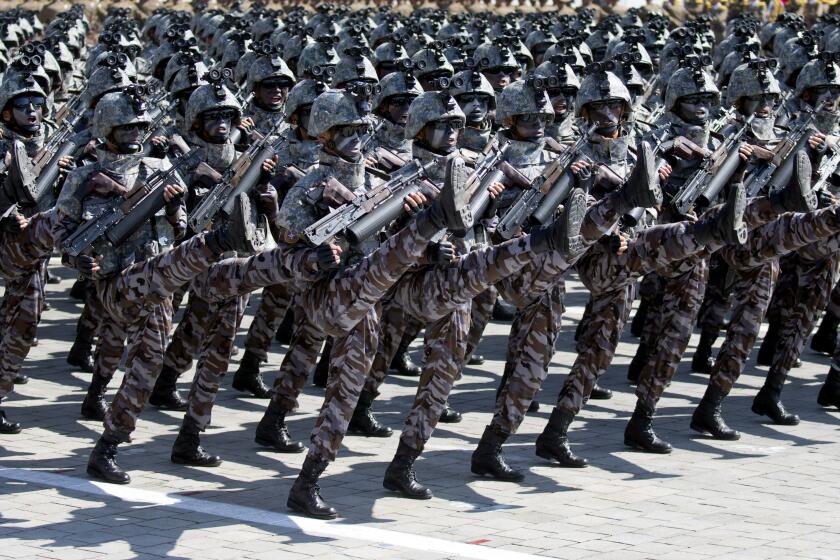An Extraordinary Link for Archenemies in Spying
MOSCOW — Leaves skittered across the quiet streets of East Berlin’s Karlshorst district on the autumn day that would be East Germany’s last, and anticipation filled the air. It was Oct. 2, 1990, a day before Germany was to become united for the first time since the end of World War II, and Karlshorst, like all of Germany, was preparing for the party of the century.
Deep inside one nondescript Karlshorst house, however, the Cold War was still very much underway. The barons of the CIA and the KGB--the spy agencies of West and East--were secretly gathering for a high-level conference.
Milton A. Bearden, chief of the CIA’s Soviet Division, and Hugh E. “Ted” Price, its chief of counterintelligence, had been summoned to a KGB safe house by their Soviet counterparts: Rem Krassilnikov and Leonid Nikitenko, the chieftains of KGB counterintelligence. A key topic, from the Soviet point of view: Why were so many KGB agents defecting to the West? Although their meeting was extraordinary, the means by which it had been arranged had quietly become standard operating procedure for the superpower spy agencies. The KGB had brought the CIA officials there by activating what the Soviets called “the Gavrilov channel,” a secret line of communications between the two spy services that has never before been publicly disclosed.
At the heart of the Gavrilov channel, named after an 18th century Russian poet, was a top-secret telephone hotline established earlier in the Cold War to arrange back-channel meetings on short notice. The hotline connected KGB headquarters in Moscow via a secure telephone link to a special phone in Bearden’s office at CIA headquarters in Langley, Va.
The Gavrilov channel allowed the CIA and KGB to address common problems while politely ignoring the espionage war their services were engaged in outside their meeting room.
“It was a concept developed when people on both sides started to say, ‘Let’s communicate, let’s talk about security threats, terrorism, things like that,’ ” Bearden said.
A Means to Ease Cold-War Mistrust
Trust went only so far; neither side ever allowed its officers to go to the conferences alone, fearful that Gavrilov might turn into an officially sanctioned means for moles to meet their handlers. Instead, the American and Russian teams came together tentatively, one step at a time, like rival Mafia capos, keeping one hand in their pockets and one eye on the exit door.
Over time, however, Gavrilov quietly helped reduce Cold War tensions, just as the more famous presidential hotline between the Kremlin and White House had done years earlier. And in the end, Gavrilov paved the way for the relationship that developed between the CIA and the SVR, the successor to the KGB’s foreign intelligence arm, after the Cold War.
In fact, through Gavrilov, KGB and CIA officials found common ground for the first time on narcotics trafficking, terrorism and, most awkwardly, the resettlement of defectors.
“There were contacts, through a confidential but official channel, between our organizations,” said Leonid V. Shebarshin, who at the time was head of the KGB’s First Chief Directorate, which handled foreign intelligence. “Occasionally, information was exchanged at the highest levels, especially on possible terrorist threats, and this channel was quite effective.”
The CIA took the first tentative steps to open a channel in the early 1980s. At a time when President Ronald Reagan was calling the Soviet Union the “evil empire,” senior CIA and KGB officials sat down for their initial off-the-record sessions in neutral cities such as Vienna, according to several CIA officials.
Burton Gerber, then chief of the Soviet Division, along with CIA counterintelligence chief David Blee, were the first CIA officials involved. So at odds with Reagan’s public line were the initial Gavrilov meetings that only a handful of senior CIA officials were told that the channel had been established.
One of the first major requests the Americans made through the Gavrilov channel was for the KGB’s help in determining the fate of William Buckley, the CIA’s Beirut station chief, who had been kidnapped by Iranian-backed Islamic Jihad terrorists in 1984.
But the Buckley case was particularly awkward for Moscow since the KGB itself had planned to kidnap another CIA officer in Beirut in the late 1970s, using local Islamic radicals to do the dirty work. The KGB-backed kidnapping plot had been canceled at the last minute by KGB chief Yuri V. Andropov, who had feared it would lead to a war of attrition with the CIA.
The KGB was not involved in Buckley’s kidnapping. Nonetheless, former KGB Major Gen. Oleg Kalugin, who thought up the KGB’s aborted kidnapping scheme in the late 1970s, now says he is convinced that the transcripts from Islamic Jihad’s brutal interrogations of Buckley were sold to Soviet intelligence. If true, that would mean that the KGB knew far more about Buckley than it was willing to tell the CIA. Buckley eventually died in captivity.
And in fact the KGB did not provide much help to the CIA in the Buckley case, and the Gavrilov channel seems to have languished for several years as a result. “We wanted to talk to them about Buckley, but nothing much came of it for a long time,” Bearden recalled.
The Soviets renewed attempts to establish a back channel in 1988 when Krassilnikov, then chief of the American department of the KGB’s Second Chief Directorate, which handled counterintelligence, raised the matter with Jack Downing, the CIA’s Moscow station chief.
Krassilnikov recalls that Downing, now the chief of the CIA’s clandestine espionage service, was wary and didn’t respond. “I think he was afraid of me,” Krassilnikov said. “I think he thought it was a trick.”
It wasn’t until the following year, 1989, as communism retreated across Eastern Europe, that the Gavrilov channel was reopened. The second round of Gavrilov meetings began with a session at the Soviet Embassy in Helsinki. That conference ended on an embarrassing note for the Americans; CIA counterintelligence chief Gus Hathaway left his wallet behind, and a car full of KGB agents had to speed through Helsinki’s downtown streets to return it to the red-faced American spy.
As the Soviet Union itself entered its death throes, the Gavrilov channel was activated more frequently. Cooperation deepened as the KGB began a desperate scramble for survival.
Most notably, the CIA sought the KGB’s cooperation as the United States built an international coalition to oppose Saddam Hussein’s invasion of Kuwait in August 1990. The KGB, meanwhile, asked for the CIA’s help to determine the fate of a Soviet diplomat who had disappeared without a trace in India.
Increasingly, the Gavrilov meetings came to be dominated by Moscow’s desperate search for answers as the trickle of KGB defectors to the West turned into a flood at the end of the Cold War.
To be sure, the KGB still had Aldrich H. Ames, its mole inside the CIA, to provide plenty of information about defectors who had been brought to the United States by the CIA. Information the KGB obtained through the Gavrilov channel may have helped the KGB make certain that Ames was telling them the truth.
And so a polite and carefully choreographed dance would be conducted at the Gavrilov meetings. KGB officials would kindly ask their CIA counterparts if they had any idea what had become of a KGB officer who had suddenly vanished, and the CIA officials would respond in equally diplomatic terms.
“We would always say that the officer in question is well, has freedom of movement, and is in another country--shorthand for saying we had him and he was living in the United States.”
As their losses through defections mounted in 1990 and 1991, the KGB officers attending the Gavrilov summits found it increasingly difficult to hide their frustrations. At the Karlshorst meeting in October 1990 on the eve of German unification, Nikitenko turned anxiously to Bearden and asked why so many of the KGB’s best were jumping to the other side.
Nikitenko’s plaintive cry seemed to be a sure sign that the KGB was crumbling, and Bearden found it impossible to contain himself. “The dogs don’t like the dog food,” Bearden quipped--only to realize that his obscure metaphor had left Nikitenko completely baffled.
KGB Grateful for News on Fallen Comrade
In the end, it was the mystery surrounding Nikitenko’s own death that finally seemed to solidify the trust between the CIA and KGB officials involved in the Gavrilov channel. The Russian spy died suddenly in 1991 while traveling in Brazil, and the KGB, uncertain whether he had been murdered, asked the CIA to help investigate. Through its contacts in the Brazilian government, the CIA determined that Nikitenko had simply died of a heart attack.
“When there was some suspicion of foul play, we would get in touch with the CIA, and we would clarify matters,” recalled former KGB intelligence chief Shebarshin. “Our man Nikitenko went abroad for a short time and died, and we had to check to see if it was a medical case or foul play. We received information from our American colleagues that they did not suspect foul play, and also they shut off any possible suspicion that they were somehow involved in the matter. I believed the information and I was grateful.”
The Gavrilov channel came out of the closet after the failed 1991 Soviet coup by Communist hard-liners and emerged as the basis for a new intelligence liaison between Washington and Moscow.
In place of Gavrilov’s small, top-secret summit meetings, entire teams of CIA and KGB experts began to hold conferences to fight such common enemies as international narcotics trafficking and the proliferation of weapons of mass destruction. The new reform-minded chief of the KGB, Vladimir V. Bakatin, quickly latched onto the emerging liaison with the CIA as a way to help Russian intelligence regain legitimacy in the wake of its leaders’ role in the failed coup.
Bakatin’s eagerness to formalize the link with the CIA soon earned him the enmity of veteran officers, who believed he was giving away the KGB store. To prove to the Americans that he was serious about improving ties, Bakatin agreed to hand over the secret KGB plans to the new U.S. embassy in Moscow, which showed where the Russians had embedded their eavesdropping devices as the building was being constructed.
A Supposed Surplus of KGB Defectors
Bearden’s exposure to the upper ranks of the KGB through Gavrilov had an unintended effect on his own career. Long before other senior CIA officials, he became convinced that the KGB had been defeated and was no longer a threat to the United States. As a result, he sent word out to CIA stations that the agency’s Soviet Division had little interest in recruiting more KGB officers. Each new defector cost the CIA at least $1 million, and Bearden believed the agency had already reeled in more than enough.
The message stunned CIA officers in Africa and elsewhere in he Third World who had long viewed their main task as recruiting Soviet officials from their local embassies. Unable to target Soviets, those officers soon found it increasingly difficult to justify their jobs.
Bearden’s edict also infuriated many of his most senior colleagues in the CIA, and today many still believe he missed a golden opportunity to rake in long-sought secrets from Moscow. “He gave up far too early,” said one former colleague. “There were things we missed out on as a result.”
Bearden remains unrepentant: “A lot of the people inside the agency who criticized me at the time didn’t know about Gavrilov and didn’t see what I saw.”
(BEGIN TEXT OF INFOBOX / INFOGRAPHIC)
About This Series
Once it was the world’s most mysterious and feared espionage organization, the “sword and shield” of the Soviet Union. But ultimately the KGB fell victim to the same forces of history that destroyed the empire it had served.
For the most part, the last KGB officers slipped away, retaining the cloak of secrecy. But now a group of former officers has stepped forward to provide an insider’s guide. They agreed to a series of interviews with the Los Angeles Times, in part to put on the record what they see as their sacrifices and professionalism in a cause now widely denigrated.
* Monday: The spy who directed Aldrich H. Ames.
* Tuesday: Two enemies, two friends.
* Today: The Gavrilov channel, the KGB-CIA hotline.
* On the Web: The complete series is available on The Times’ Web site at http://arstechnica.netblogpro.com/kgb
More to Read
Sign up for Essential California
The most important California stories and recommendations in your inbox every morning.
You may occasionally receive promotional content from the Los Angeles Times.










